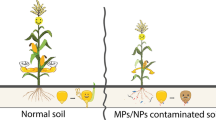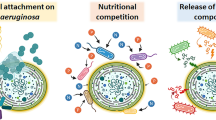Abstract
Accelerated eutrophication is common to many freshwater and marine environments and often co-occurs with the presence of anthropogenic chemicals. However, the toxic effects of common chemical stressors such as herbicides in the presence of elevated nutrients are not well understood for most aquatic flora, particularly vascular species. To provide insight, field-collected Vallisneria americana Michx. (wild celery) were sequentially exposed to three nutrient concentrations for 3 months and then to nominal 11 and 110 μg L−1 atrazine for 96 h. Nutrient concentrations (combined NH4 +, NO2 −, NO3 −, PO4 −) were based on ambient concentrations in the St. Johns River (FL) and ranged from 0.013 to 0.668 mg L−1. Nutrient pretreatment potentiated the toxicity of atrazine as determined by chlorophyll fluorescence activity. Electron transport rates (ETR) were significantly less (48–59%) for plants pretreated with low and ambient nutrient levels in the presence of an average of 107.5–128.1 μg L−1 atrazine. Significant ETR reductions were also observed for plants exposed to an average of 11.4 μg L−1 atrazine after exposure to nutrients three times the ambient concentration in the St. Johns River. The results indicate the importance of considering the presence of nutrients in chemical hazard assessments, particularly for phytotoxicants and nontarget vascular plants.






Similar content being viewed by others
References
Baker NR, Oxborough K (2004) Chapter 3: chlorophyll fluorescence as a probe of photosynthetic productivity. In: Papageorgiou GC, Govindjee (eds) Chlorophyll a fluorescence: a signature of photosynthesis. Springer, The Netherlands, pp 65–82
Beck MW, Heck KL Jr, Able KW, Childers DL, Eggleston DB, Gillanders BM, Halpern BS, Hays CG, Hoshino K, Minello TJ, Orth RJ, Sheridan PF, Weinstein MP (2003) Issues in ecology #11: the role of nearshore ecosystems as fish and shellfish nurseries. Ecological Society of America, Washington, DC
Beer SB, Vilenkin A, Weil M, Veste L, Eshel S (1998) Measuring photosynthetic rates in seagrasses by pulse amplitude modulated (PAM) fluorometry. Mar Ecol Prog Ser 174:293–300
Beer S, Bjork M, Gademann R, Ralph P (2001) Measurements of photosynthetic rates in seagrass. In: Short FT, Coles RG (eds) Global seagrass research methods. Elsevier Science, Amsterdam, pp 183–198
Berry HD, Sewell AT, Wyllie-Echeverria S, Reeves BR, Mumford TF Jr, Skalski JR, Zimmerman RC, Archer J (2003) Puget Sound Submerged Vegetation Monitoring Project: 2000–2002 Monitoring Report. Nearshore Habitat Program, Washington State Department of Natural Resources, Olympia, p 60
Boustany RG, Michot TC, Moss RF, Lawton L (2000) Effects of variable nutrient loadings on biomass and growth of Vallisneria americana in lower St. Johns River, FL, USA. Final Report submitted to St. Johns River Water Management District, Palatka, FL
Boyce ED, Siewicki TC, Key PB, Fulton MH (2003) Preliminary assessment of ecological risks from pesticides currently used in the St. Johns River, Florida, Watershed. Presentation to: SouthEast Coastal Ocean Science (SECOS) Conference, Charleston, South Carolina, January, 2003
Costanza R, d’Arget R, de Groot R, Farber S, Grasso M, Hannon B, Limburg K, Naeom K, O’Neill RV, Paruelo J, Raskin RG, Sutton P, van Belt M (1997) The value of the world’s ecosystem services and natural capital. Nature 387:253–260
Deegan LA (2002) Lessons learned: the effects of nutrient enrichment on the support of nekton by seagrass and salt marsh ecosystems. Estuaries 25:727–742
Demcheck DK, Swarzenski CM (2003) USGS Fact Sheet: atrazine in Southern Louisiana Streams, 1998–2000. National Water Quality Assessment Program FH-011-03
Giddings JM, Anderson TA, Hall LW Jr, Kendall RJ, Richards RP, Solomon KR, Williams WM (2005) A probabilistic aquatic ecological risk assessment of atrazine in North American surface waters. SETAC, Pensacola, p 432
Gilliom RJ, Barbash JE, Crawford CG, Hamilton PA, Martin JD, Nakagaki N, Nowell LH, Scott JC, Stackelberg PE, Thelin GP, Wolock DM (2006) The quality of our nation’s waters—pesticides in the nation’s streams and ground water, 1992–2001: USGS circular 1291, 172 pp
Heinz Walz GmbH (1998) Underwater fluorometer diving-PAM, submersible photosynthesis yield analyzer: handbook of operation. Effeltrich, Germany
Gorsuch JW, Lower WR, Lewis MA, Wang W (1991) Plants for toxicity assessment: second volume. Symposium on Use of Plants for Toxicity Assessment 2nd: 1990: San Francisco, CA, Am. Soc. Testing Materials (ASTM). Committee E-47 on Biological Effects and Environmental Fate. Subcommittee E47.11 on Plant Toxicity Series: ASTM STP 1115
Handley L, Altsman D, DeMay R (eds) (2007) Seagrass status and trends in the northern Gulf of Mexico; 1940–2002: US Geological Survey Scientific Investigations Report 2006–5287, 267 pp
Hohnberg D, Ralph PJ, Jones H (2003) Toxicity of the herbicide atrazine at environmental concentrations to Vallisneria gigantea, assessed using chlorophyll fluorescence. Australasian J Ecotox 9:93–100
Jaggers BV (1994) Vallisneria americana: considerations for restoration in Florida. Technical Report. Florida Game and Fresh Water Fish Commission, Eustis, FL, p 33
Klaine SJ, Lewis MA (1995) Algal and plant toxicity testing. In: Hoffman DJ, Rattner BA, Burton GA Jr, Cairns J Jr (eds) Handbook of ecotoxicology, 2nd edn. Lewis, Boca Raton, pp 163–184
Klaine SJ, Lewis ML, Knuteson SL (2002) Phytotoxicity. In: Hoffman DJ, Rattner BA, Burton GA Jr, Cairns J Jr (eds) Handbook of ecotoxicology, 2nd edn. Lewis, Boca Raton, pp 191–218
Korschgen CE, Green WL (1988) American wildcelery (Vallisneria americana): Ecological considerations for restoration. US Fish and Wildlife Service, Fish and Wildlife Technical Report 19. Jamestown, ND: Northern Prairie Wildlife Research Center Online. http://www.npwrc.usgs.gov/resource/plants/wildcel/index.htm (Version 16JUL97)
Kroening SE (2004) Streamflow and water quality characteristics at selected sites of the St. Johns River in Central Florida, 1933–2002. Scientific Investigation’s Report, 2004–5177, USGS 102 pp
Lewis MA, Quarles RL, Dantin DD, Moore JC (2004) Evaluation of a Florida coastal golf complex as a local and watershed source of bioavailable contaminants. Mar Pollut Bull 48:254–262
Maxwell K, Johnson GN (2000) Chlorophyll fluorescence—a practical guide. J Exp Botany 51:659–668
McPherson BF, Miller RL, Haag KH, Bradner A (2000) Water quality in South Florida. 1996–1998. USGS Circular 1207, NAWQA Program, Reston, VA. 33 pp
Michot TC, Chadwick PC (1994) Winter biomass and nutrient values of three seagrass species as potential foods for redheads (Aythya americana Eyton) in Chandeleur Sound, Louisiana. Wetlands 14:276–283
Millennium Ecosystem Assessment (2005) Ecosystems and human well-being: wetlands and water synthesis. World Resources Institute, Washington, DC
Mitchell SF, Perrow MR (1998) Interactions between grazing birds and macrophytes. In: Jeppesen E, Ma Sondergaard, Sondergaard Mo, Christoffersen K (eds) The structuring role of submerged macrophytes in lakes. Springer, New York, pp 175–196
Neckles HA, Wetzel RL, Orth RJ (1993) Relative effects of nutrient enrichment and grazing on epiphyte-macrophyte (Zostera marina L.) dynamics. Oecologia 93:285–295
Orth R, Moore K (1984) Distribution and abundance of submerged aquatic vegetation in Chesapeake Bay: an historical perspective. Estuaries 7:531–540
Paulic M, Hand J, Lord L (1996) Water quality assessment for the State of Florida. Sect. 305 (B) Main Report, Florida Department of Environmental Protection, Tallahassee
Ralph PJ, Gademann R (2005) Rapid light curves: a powerful tool for the assessment of photosynthetic activity. Aqua Bot 86:253–259
Ralph PJ, Gademann R, Dennison WC (1998) In situ seagrass photosynthesis measured using a submersible pulse-amplitude modulated fluorometer. Mar Biol 132:367–373
Rozas LP, Minello TJ (2006) Nekton use of Vallisneria americana Michx. (wild celery) beds and adjacent habitats in coastal Louisiana. Estuaries Coasts 29:297–310
Rybicki NB, Carter V (1986) Effects of sediment depth and sediment type on the survival of Vallisneria americana grown from tubers. Aqua Bot 26:307–323
Schreiber U (1997) Chapter 2: chlorophyll fluorescence: an indicator of photosynthetic energy conversion. In: Schreiber U (ed) Chlorophyll fluorescence and photosynthetic energy conversion: simple introductory experiments with the teaching PAM chlorophyll fluorometer. Heinz Walz GmbH, Effeltrich, pp 7–11
Schreiber U (2004) Chapter 11: pulse-amplitude-modulated (PAM) fluorometry and saturation pulse method: an overview. In: Papageorgiou GC, Govindjee (eds) Chlorophyll a fluorescence: a signature of photosynthesis. Springer, The Netherlands, pp 279–319
Solomon KR, Baker DB, Richards RP, Dixon KR, Klaine SJ, La Point TW, Kendall RJ, Weisskopf CP, Giddings JM, Giesy JP, Hall LW Jr, Williams WM (1996) Annual review: ecological risk assessment of atrazine in North American surface waters. Environ Toxicol Chem 15:31–76
Twilley RR, Kemp WM, Staver KW, Stevenson JC, Boynton WR (1985) Nutrient enrichment of estuarine submersed vascular plant communities. 1. Algal growth and effects on production of plants and associated communities. Mar Ecol Prog Ser 23:179–191
USEPA (1979) Methods for chemical analysis of water and wastes. USEPA-600/4-79-020, Cincinnati, OH
USEPA (1996) Environmental indicators of water quality in the USEPA-841-R-96–002. Office of Water, Washington, DC
USEPA (2003a) Interim reregistration eligibility decision for atrazine—Case No. 0062: US Environmental Protection Agency. http://www.epa.gov/oppsrrd1/REDs/atrazine_ired.pdf. Accessed January 11, 2007
USEPA (2003b) Assessment of potential mitigation measures for atrazine. Biological and Economic Analysis Division, Office of Pesticide Programs
USEPA (2003b) Ambient aquatic life water quality criteria for atrazine—revised draft. EPA-822-R-03–023. Office of Science and Technology. Health and Ecological Criteria Div, Washington, DC
USEPA (United States Environmental Protection Agency) (2006) Ecological benefits assessment strategic plan. EPA-240-R-06-001. Office of the Administrator, Washington, DC. http://www.epa.gov/economics/
USGS (US Geological Survey) (2003) National Water Quality Assessment Program: Atrazine in Southern Louisiana streams 1998–2000. USGS fact sheet FS-011-03
Wetzel RG, Likens GE (1991) Limnological analyses. Springer, New York
White AQ, Pinto GF, Robinson AP (2002) Seasonal distribution of manatees, Trichechus manatus latirostris, in Duval County and adjacent waters, Northeast Florida. Florida Scientist 65:208–221
Ziegler S, Benner R (1999) Nutrient cycling in the water column of a subtropical sea grass meadow. Mar Ecol Prog Ser 188:51–62
Zimmerman RC, Reguzzoni JK, Wyllie-Echeverria S, Josselyn M, Alberte RS (1991) Assessment of environmental suitability for growth of Zostera marina L. (eelgrass) in San Francisco Bay. Aqua Bot 39:353–366
Acknowledgements
This research was a collaborative project between the USEPA Gulf Ecology Division (Gulf Breeze, FL) and the USGS National Wetlands Research Center (Lafayette, LA). Field collection assistance was provided by personnel from the St. Johns River Water Management District (SJRWMD), Palatka, FL. Support for mesocosm operation provided by SJRWMD. Greenhouse facility provided by University of Louisiana, Lafayette, and maintained by USGS National Wetlands Research Center.
Disclaimer
The information in this document has been funded wholly (or in part) by the US Environmental Protection Agency. It has been subjected to review by the National Health and Environmental Effects Research Laboratory and approved for publication. Approval does not signify that the contents reflect the views of the Agency, nor does mention of trade names or commercial products constitute endorsement or recommendation for use.
Author information
Authors and Affiliations
Corresponding author
Rights and permissions
About this article
Cite this article
Dantin, D.D., Boustany, R.G., Lewis, M.A. et al. Effects of Nutrient Pre-Exposure on Atrazine Toxicity to Vallisneria americana Michx. (Wild Celery). Arch Environ Contam Toxicol 58, 622–630 (2010). https://doi.org/10.1007/s00244-009-9399-3
Received:
Accepted:
Published:
Issue Date:
DOI: https://doi.org/10.1007/s00244-009-9399-3




